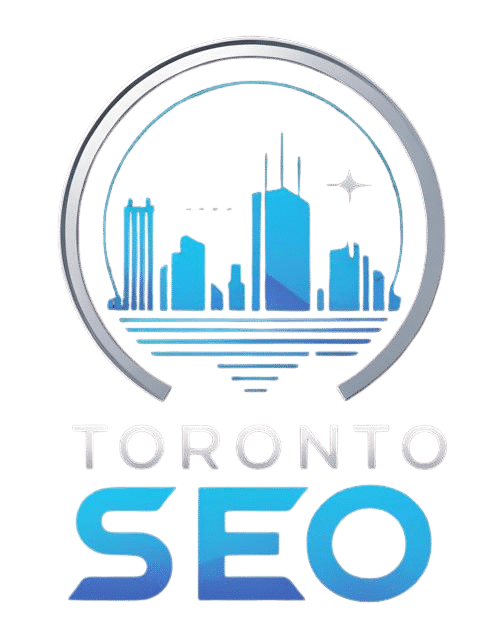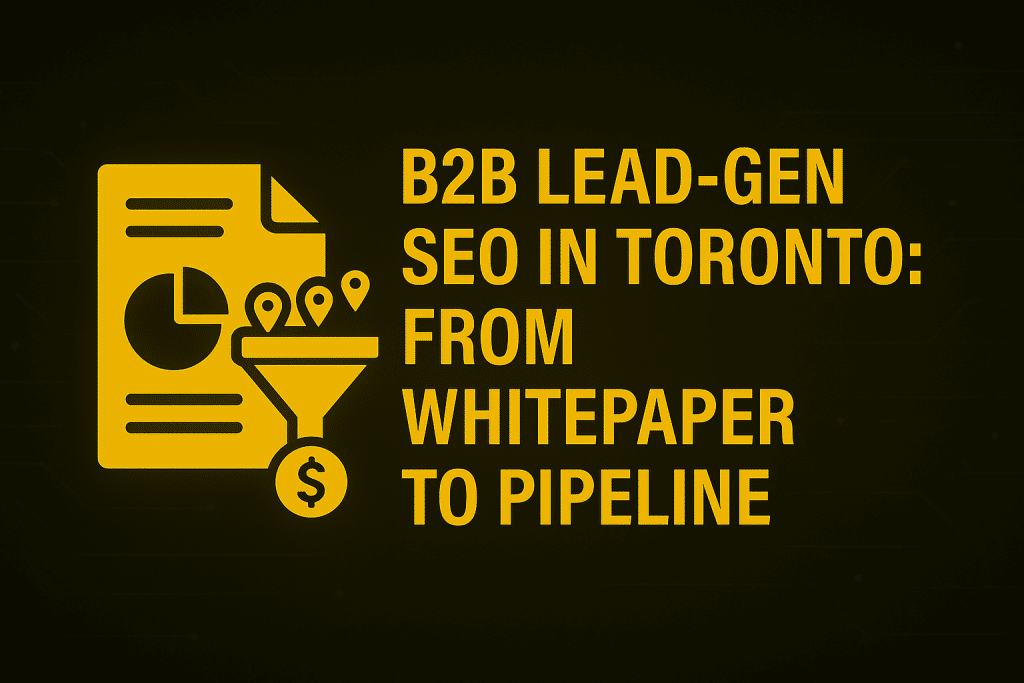B2B lead generation in Toronto has evolved beyond gated PDFs and cold calls. The most successful companies are now building SEO-driven lead funnels that turn whitepapers, case studies, and long-form content into predictable sales pipelines. Toronto’s competitive business environment demands a strategy that blends thought leadership, content architecture, and technical SEO — not just ads or one-off campaigns.
In this comprehensive guide, you’ll learn how to transform your B2B whitepapers and content assets into powerful SEO magnets that continuously attract, nurture, and convert qualified leads.
Why B2B SEO in Toronto Requires a Full-Funnel Approach
Toronto’s B2B landscape is crowded with SaaS startups, enterprise service providers, fintech firms, and agencies. Buyers no longer convert after a single visit; they go through a research journey — often consuming multiple assets before engaging a sales rep.
A full-funnel SEO strategy ensures that:
Top-of-funnel content (like educational blogs) drives organic discovery.
Mid-funnel assets (like whitepapers and webinars) capture leads through gated CTAs.
Bottom-funnel pages (like solution pages and case studies) close deals by proving expertise.
Toronto brands that embrace this multi-layered approach are significantly outperforming competitors who rely solely on PPC or basic on-page optimization. In fact, as highlighted in SEO vs Google Ads in Toronto, SEO delivers compounding returns, while paid ads stop working the moment you pause the spend.
Crafting High-Value Whitepapers That Rank and Convert
1. Align Topics with Search Intent and Business Value
Before writing a whitepaper, validate the topic through keyword research and intent mapping. Instead of generic reports, focus on pain points your ideal buyers actively search for. For example:
“Toronto B2B data privacy regulations 2025”
“AI for enterprise marketing teams in Canada”
“Hybrid cloud migration strategies for financial firms”
Use clustering strategies similar to those outlined in Toronto Marketing Agencies Are Winning with AI-Driven Keyword Clustering to group semantically related keywords, then build your whitepaper around the cluster. This ensures ranking for multiple queries and capturing diverse buyer journeys.
2. Optimize for On-Page SEO and User Experience
Whitepapers aren’t just PDFs anymore. The best-performing assets in 2025 are:
HTML landing pages optimized for Core Web Vitals.
Interactive or scrollable content for mobile users.
Schema markup to help Google understand the asset type.
Internal linking to relevant service or blog pages to build topical authority.
For example, when creating a whitepaper about algorithm updates, link to educational content like Understanding Google’s Latest Algorithm Update to reinforce relevance.
Building SEO Landing Pages that Feed the Pipeline
1. Gated vs. Ungated: Striking the Right Balance
Toronto B2B marketers often struggle between SEO visibility and lead capture. Gated PDFs alone don’t rank — Google can’t crawl behind the form. Instead:
Publish an SEO-optimized landing page summarizing the key insights.
Gate only the full download behind a short form.
Offer value upfront to encourage both ranking and conversions.
Government and authoritative sources like Canada.ca often publish public frameworks. Citing and linking to such credible resources within your landing page builds trust and E-E-A-T.

2. Funnel Traffic from Top Content to Whitepapers
A well-linked content ecosystem ensures that traffic from educational blogs flows directly into lead magnets. For instance, a blog on technical SEO best practices for enterprise teams can naturally guide readers to download a comprehensive migration checklist whitepaper.
Internal linking to cornerstone guides like Content Optimization: Boosting Engagement and Rankings strengthens authority and moves users deeper into your funnel.
Using Case Studies and Pillar Content to Close Deals
1. Case Studies as Conversion Powerhouses
Case studies bridge the gap between interest and decision. Pair your whitepapers with search-optimized case study pages showcasing measurable results. For example, How a Toronto Business Tripled Organic Leads in Just 90 Days demonstrates clear ROI, which is critical for B2B buyers in regulated industries.
2. Pillar Content to Anchor Authority
Develop long-form pillar pages (3,000+ words) targeting competitive keywords like “Toronto B2B SEO strategy” or “Enterprise lead generation SEO Canada.” These should internally link to cluster pages, whitepapers, and case studies, forming a content hub that signals authority to Google.
Toronto SEO agencies leading in 2025 are leveraging this approach, as detailed in Top SEO Agencies in Toronto Are Using AI to Outrank the Competition.
Technical SEO Foundations for B2B Lead Generation
1. Structured Data and Schema Markup
Adding Article, Organization, and FAQ schema enhances visibility in SERPs. B2B landing pages should also use Lead Generation schema, helping search engines identify CTAs and form elements.
2. Page Speed and Core Web Vitals
Toronto’s enterprise buyers often access content from corporate networks with strict security layers. Slow landing pages cost leads. Investing in performance optimization and audits similar to those described in WordPress Technical SEO Audit Toronto ensures smooth user journeys.
3. Crawlability and Indexation
Ensure your gated assets are properly linked and referenced in XML sitemaps, with the landing pages set to index and the PDF assets set to noindex, preserving crawl budget.
Distribution: Turning SEO Traffic into SQLs
1. Retargeting and Account-Based Marketing (ABM)
Not all whitepaper visitors convert immediately. Use retargeting pixels and ABM tools to re-engage decision-makers. Targeting specific industries (like financial services or manufacturing) with tailored follow-up content amplifies lead quality.
2. Email Nurturing Sequences
Once leads download the whitepaper, they should enter segmented email workflows that offer:
Case studies relevant to their industry.
Webinars expanding on the whitepaper insights.
Consultations or strategy sessions.
Integrating your CRM with SEO-driven lead capture allows marketing teams to move prospects from MQL to SQL efficiently.
Measuring ROI: From Organic Click to Closed Deal
Toronto’s B2B marketers must go beyond vanity metrics. Real measurement involves tracking leads from first touch to revenue. Key performance indicators include:
Organic traffic to whitepaper landing pages.
Form fill conversion rates.
SQL to deal conversion ratio.
Cost per lead vs. PPC channels.
Using analytics frameworks such as those discussed in How to Track SEO Performance with Analytics ensures transparency and attribution accuracy.
Additionally, referencing structured methodologies like those outlined by Google’s Search Central Documentation provides an authoritative basis for technical validation.
Integrating B2B SEO with Toronto’s Competitive Digital Ecosystem
SEO doesn’t operate in isolation. Leading Toronto firms combine SEO, PR, and PPC to dominate their niches. A strong whitepaper strategy supported by AI-powered clustering, E-E-A-T content, and precise technical implementation creates an always-on lead generation engine.
By aligning SEO with sales enablement and distribution tactics, businesses can turn content assets into a consistent pipeline of high-quality B2B leads.
Take the Next Step: Build Your SEO-Driven Pipeline
Toronto’s B2B ecosystem rewards brands that publish authoritative content, optimize for search, and systematically nurture leads. Whether you’re launching your first gated asset or scaling an enterprise funnel, the blueprint remains clear: whitepapers → optimized landing pages → nurturing sequences → closed deals.
To develop a custom B2B SEO strategy tailored to your industry, Contact Toronto SEO for an expert consultation.


